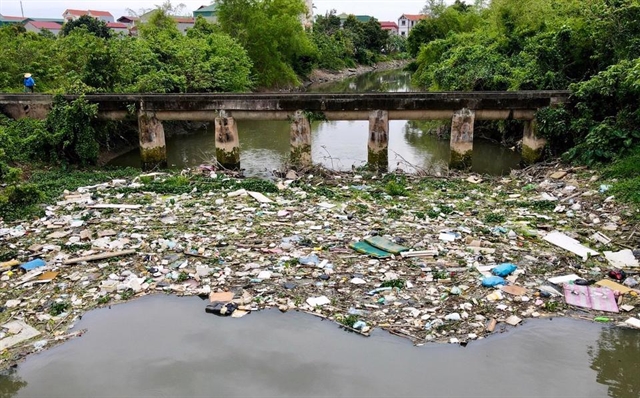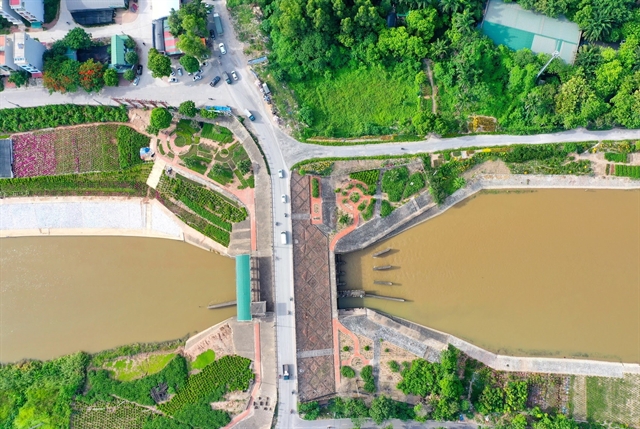 Environment
Environment

 |
| Garbage stagnates on the Cầu Bây River in Hà Nội's Gia Lâm District. Cau Bay River is a major pollutant leading to the Bắc Hưng Hải irrigation system. — Photo kinhtedothi.vn |
HÀ NỘI — Pollution on the main rivers and canals of Bắc Hưng Hải irrigation system in the northern region has become graver in recent years.
Built in 1958, the Bắc Hưng Hải system has a total length of 232km of dredge canals, dams and dykes covering the four localities of Hưng Yên, Hải Dương and Bắc Ninh, and part of the Hà Nội capital city. It is designed to provide water for 135,000ha of crops, control flooding for 185,000ha of farmland, and supply drinking water for millions of people.
The pollution has become a big concern and resulted in serious consequences to people's lives, production and the environment.
Five years ago, Lê Ngọc Hà moved from Hà Nội’s Khâm Thiên Street to Sài Đồng Ward of Long Biên District. He had to get used to living with the smell of wastewater from the Cầu Bây River, the main polluted stream pouring into the Bắc Hưng Hải irrigation system.
“On hot or humid days, the strong stench rising from the Cầu Bây River makes us dizzy and sick,” Hà told Kinh Tế & Đô Thị (Economic & Urban Affairs) newspaper.
“The most worrisome are the young children who have asthma and minor illnesses all day. I and my wife plan to sell the house to move to another place but for many months now, no one has asked to buy,” Hà said.
“In the past, when the irrigation system was not polluted, in the Xuân Thuỵ sluice area a lot of people lived. Now, the area is much quieter," said Nguyễn Văn Vinh, a resident in the area along the Cầu Bây River.
According to the 50-year-old man, pollution on the Bắc Hưng Hải irrigation system’s section which flows from the Cầu Bây River has been occurring for 20 years.
“At present, people living in the area have to close their doors and windows all day because of the stinky smell from the polluted river in front of their houses,” said Vinh.
The pollution on the Kiên Thành River and Đông Dù Canal in Tân Quang Commune, Văn Lâm District of Hưng Yên Province is also very serious. Ngọc Đà sluice in Tân Quang Commune carries wastewater from residential areas and industrial clusters, and then pours into Đồng Dù canal, one of the main routes leading wastewater into the Bắc Hưng Hải irrigation system.
The untreated wastewater is always black and stinky.
Many farmers in the area can not use the river water for irrigation any more.
“In the past, we used water of the Kiến Thành River to irrigate my peach garden. But in recent years, the river water has been seriously polluted. Like many other households, I have to drill well to take underground water for my crops,” said Phùng Viết Hưng, a peach farmer in Ngọc Đà Village.
 |
| The main culvert structure on the Bắc Hưng Hải irrigation system. — Photo from the Directorate of Water Resources |
Because the water source is not safe, many families that depend on supply from the Bắc Hưng Hải irrigation system are no longer interested in agricultural production.
Trịnh Thị Minh Loan, a resident in Kiêu Kỵ Commune of Hà Nội’s Gia Lâm District, said that her family has more than 720sq.m of rice paddy fields.
Now, she has stopped rice cultivation because the water of Cầu Bây River is polluted, which makes production difficult. So her family has rented it to people in Văn Giang District to grow fruits.
According to Phạm Gia Hân, director of the Gia Lâm Irrigation Investment and Development Company, because the water source of Cầu Bây River is polluted, in the spring crop every year, the company has to operate the Vàn pump water from the Đuống River to dilute the water of the Cầu Bây River.
The quality of water supplied to thousands of hectares has improved, but it has also significantly increased the cost of electricity to operate the irrigation system, said the director.
A survey by the Việt Nam Irrigation Institution showed that 40 out of 83 main rivers and canals of the Bắc Hưng Hải irrigation system are severely polluted.
The water in the canals and rivers is black, stinky and has no living organisms.
There are only 20 slightly polluted routes where the water can still be used for irrigation and production purposes.
According the Irrigation Department, the polluted water sources of the Bắc Hưng Hải irrigation system have been directly affecting the supply of irrigation water for 110,000ha of arable land, 12,000ha of aquaculture and water for daily life for more than 3 million people in Hải Dương, Hưng Yên, Bắc Ninh and Hà Nội as well as the negative impact on the ecological environment of the basin system.
Main cause of pollution
According to experts, the main cause of pollution to the irrigation system is waste from industrial zones, craft villages and households along the irrigation channels.
At present, there are more than 20 industrial zones in the irrigation system area. Most of the zones have wastewater treatment systems but only with small capacities.
For example, in Thăng Long Industrial Park 2 in Hưng Yên Province, the designed water supply capacity is 18,000cu.m per day but the wastewater treatment capacity is only 3,000cu.m per day.
Currently, there are about 100 craft villages in the area with potentially high-risk pollution sources such as food processing, textiles, gold-smithing, and bamboo weaving.
Most of the wastewater from craft villages is discharged directly into canals and then into the Bắc Hưng Hải irrigation system.
Strict penalties
Strict handling of acts causing pollution is considered a necessary solution to create deterrence and prevent acts of "killing" important irrigation systems. In Hưng Yên Province, the area with the largest amount of waste discharge into the system, the environmental police force has been quite active in recent years.
During 2017-2021, the provincial police uncovered 143 violation cases and fined violators VNĐ9.3 billion (US$400,000).
According to Nguyễn Việt Anh, vice director of the Irrigation Work Management Department, the four localities in the irrigation system needed to be more responsible in managing waste water from urban areas, industrial zones, craft villages and especially from people's activities.
In order to control wastewater, localities needed to step up investment in building wastewater collection systems, and regularly monitor water quality before discharging it into the irrigation system, said Việt Anh.
Meanwhile, vice director of the Northern Environment Protection Department Hoàng Văn Vy said that in order to manage water resources in the irrigation system effectively, localities should have information on the current status of discharge points and the load-carrying capacity of rivers and canals.
Besides this, localities should not grant construction permits for urban development projects which do not have wastewater treatment systems in order to ensure that the irrigation systems do not suffer more pollution, he said. — VNS

.jpg)


